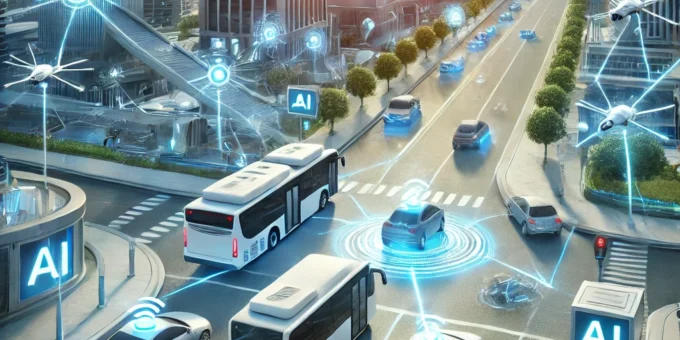
Introduction
Artificial Intelligence (AI) is revolutionizing the transportation industry, leading us toward an era of autonomous vehicles (AVs) and smart mobility solutions. As self-driving technology advances, it promises to enhance road safety, reduce traffic congestion, lower emissions, and redefine urban mobility. With companies like Tesla, Waymo, and NVIDIA leading the way, AI-driven transportation is no longer a distant dream but an imminent reality.
But what exactly enables vehicles to drive themselves? What are the challenges, and how will AI transform personal, commercial, and public transportation? This article explores the role of AI in autonomous vehicles, its impact on society, and the future of transportation.
What Are Autonomous Vehicles?
Autonomous vehicles (AVs), commonly referred to as self-driving cars, use AI, sensors, and real-time data processing to navigate without human intervention. The concept dates back to the 1920s, but modern AV technology gained momentum in the early 2000s, driven by advancements in machine learning, computer vision, and sensor technology.
Autonomous vehicles can be classified based on their levels of automation, ranging from manual operation to full autonomy.
Levels of Vehicle Autonomy
The Society of Automotive Engineers (SAE) defines six levels of vehicle automation:
- Level 0: No automation (human driver controls everything).
- Level 1: Driver assistance (adaptive cruise control, lane-keeping assist).
- Level 2: Partial automation (Tesla’s Autopilot, GM’s Super Cruise).
- Level 3: Conditional automation (hands-free driving in specific conditions).
- Level 4: High automation (fully autonomous within designated areas).
- Level 5: Full automation (no human driver required).
Currently, most self-driving systems are at Level 2 or 3, but advancements in AI are pushing toward Level 5 autonomy.
How AI Powers Autonomous Vehicles
AI is the brain of self-driving vehicles, enabling them to sense, process, and act based on their surroundings. AI technologies driving autonomy include:
1. Machine Learning and Deep Learning
- AI learns from vast amounts of driving data to recognize road patterns, objects, and hazards.
- Neural networks help vehicles predict movements of pedestrians, other cars, and obstacles.
2. Computer Vision
- AI-powered cameras and sensors detect traffic lights, road signs, and lane markings.
- Facial recognition technology monitors driver attention and fatigue.
3. Sensor Fusion
- LiDAR (Light Detection and Ranging) creates 3D maps of the surroundings.
- Radar and ultrasonic sensors detect nearby objects in all weather conditions.
4. AI Decision-Making
- AI algorithms analyze traffic conditions and make real-time decisions on braking, accelerating, and lane changes.
The Role of AI in Traffic Management
AI is not just transforming vehicles—it’s also revolutionizing traffic management by:
- Optimizing traffic light sequences to reduce congestion.
- Predicting peak traffic hours and suggesting alternative routes.
- Enabling smart city integration for improved public transport efficiency.
By integrating AI with Vehicle-to-Everything (V2X) communication, transportation systems become safer and more efficient.
Safety and Security in AI-Driven Vehicles
Safety is a major driver for AI in autonomous transportation. AI enhances safety by:
- Reducing human errors, which cause 90% of road accidents.
- Enabling collision avoidance systems to prevent crashes.
- Implementing AI-driven cybersecurity measures to prevent hacking of AV systems.
AI in Public Transport and Ride-Sharing
Autonomous vehicles are reshaping public transportation with:
- Self-driving taxis (e.g., Waymo One, Cruise AV).
- AI-powered buses reducing operational costs.
- On-demand ride-sharing services optimizing urban mobility.
By reducing costs and increasing efficiency, AI-driven transport is making cities more accessible and sustainable.
Electric and AI-Driven Autonomous Vehicles
AI and electric vehicles (EVs) are a perfect combination, offering:
- Optimized battery management for longer range.
- AI-driven charging stations for efficient energy distribution.
- Reduced carbon emissions, making transportation greener.
The future of AI-powered electric AVs aligns with global sustainability goals.
The Future of AI and Transportation
The next decade will bring significant changes, including:
- Mass adoption of Level 5 self-driving cars.
- AI-powered smart roads with real-time traffic management.
- Autonomous delivery and logistics solutions.
- Integration of AI with 5G connectivity for instant data exchange.
AI is set to redefine transportation, making it safer, smarter, and more efficient.
Conclusion
AI and autonomous vehicles are revolutionizing transportation, enhancing road safety, traffic efficiency, and sustainability. As technology advances and regulations evolve, AI-driven transportation will become a mainstream reality. The journey toward full autonomy is complex, but the benefits far outweigh the challenges.